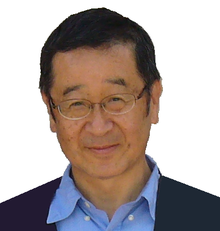Yoshihisa Yamamoto (scientist)
| Yoshihisa Yamamoto | |
|---|---|
 |
|
| Born |
November 21, 1950 (age 66) Tokyo, Japan |
| Citizenship | Japan |
| Alma mater |
University of Tokyo |
| Known for | Quantum-dot single-photon sources;Differential phase-shift quantum key distribution; Quantum-dot spin qubits;Exciton-polaritons. |
| Awards |
Medal of Honour with Purple Ribbon. Nishina Memorial Prize (1992) |
| Scientific career | |
| Doctoral advisor | Hisayoshi Yanai; Takeshi Kamiya |
| Other academic advisors | Yasuharu Suematsu |
| Doctoral students | Isaac Chuang (MIT); Charles Santori (Verily) |
| Other notable students | Joseph Jacobson (MIT) |
Medal of Honour with Purple Ribbon.
Yoshihisa Yamamoto (山本 喜久 Yamamoto Yoshihisa) is a scientist and engineer and winner of the Medal of Honour with Purple Ribbon.
Yamamoto was born in Tokyo on November 21, 1950. In 1973 he got his B.S. degree from the Tokyo Institute of Technology. He continued his studies at the University of Tokyo where he earned a M.S. in 1975 and a Ph.D. in 1978. Since 1992 he is a professor of applied physics and electrical engineering at Stanford University in the United States. Since 2003 he also has professorships at the University of Tokyo and the National Institute of Informatics in Tokyo.
Yamamoto's scientific focuses in the 1980s were optical fiber communications, semiconductor lasers, quantum non-demolition measurement and quantum optical effects. His most prominent work in the 1990s is in semiconductor quantum optics (especially involving microcavities and quantum wells) and quantum effects and noise in electronic devices.
During the 2000s, his most prominent work was on the development of optically-active quantum dots as a platform for quantum information processing (both as single-photon sources for quantum cryptography, and as hosts for spin qubits), and his work on exciton-polaritons,. Yamamoto was also active in the development of both theory and realization of quantum key distribution protocols. Landmark papers from this era include the demonstration of indistinguishable photons from a single quantum dot; the proposal for biexciton cascade as a method for generating entangled photons (for QKD) from a single quantum dot (this is the proposal underlying essentially all QD entangled-photon sources, such as those reviewed in ), and demonstration of control of a single spin qubit in a quantum dot using optical pulses.
...
Wikipedia
